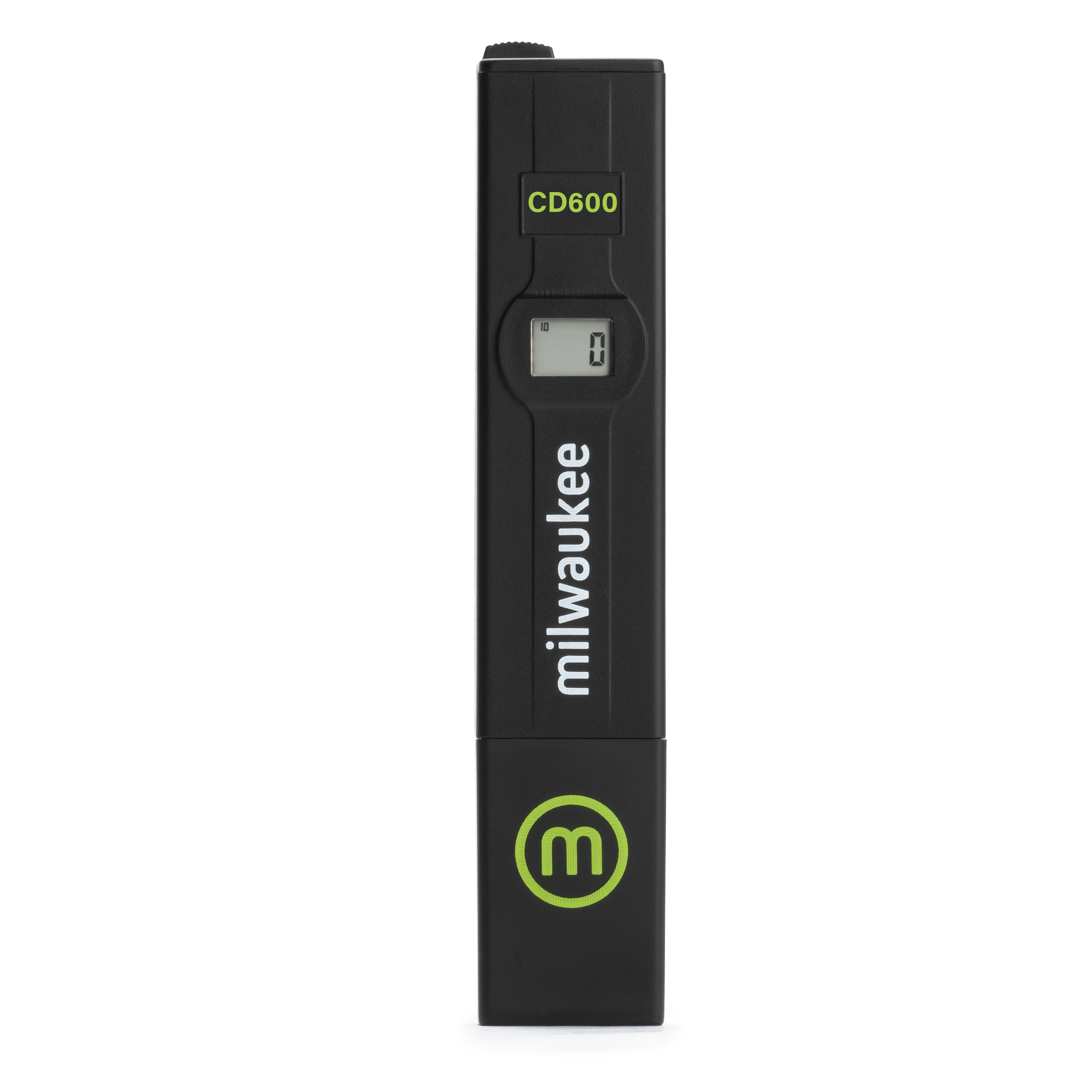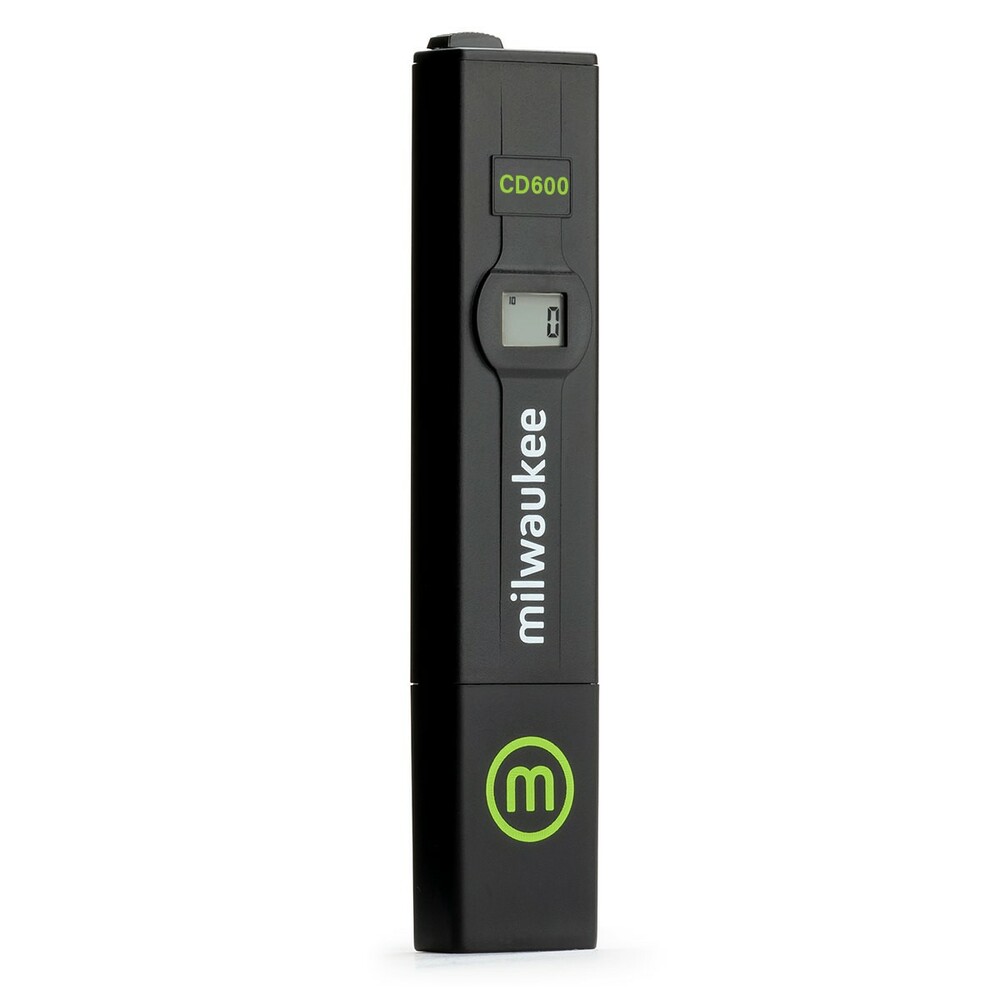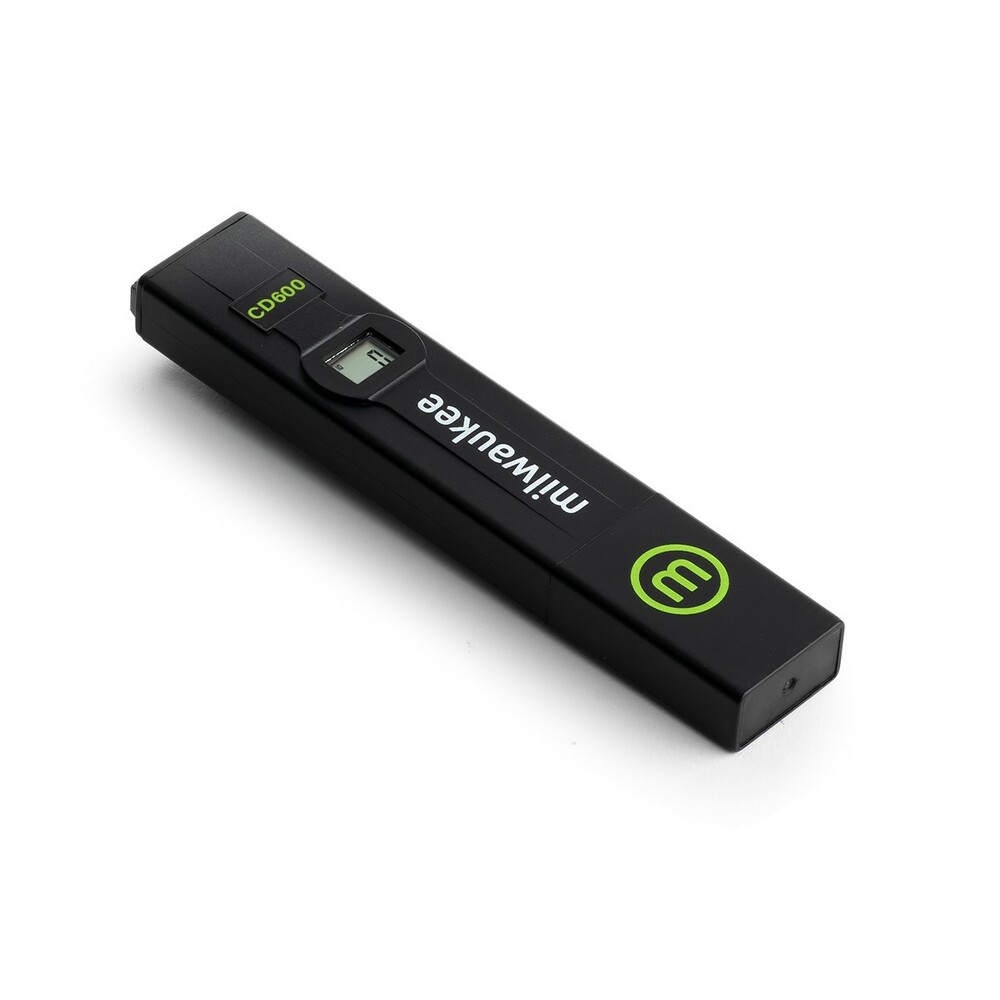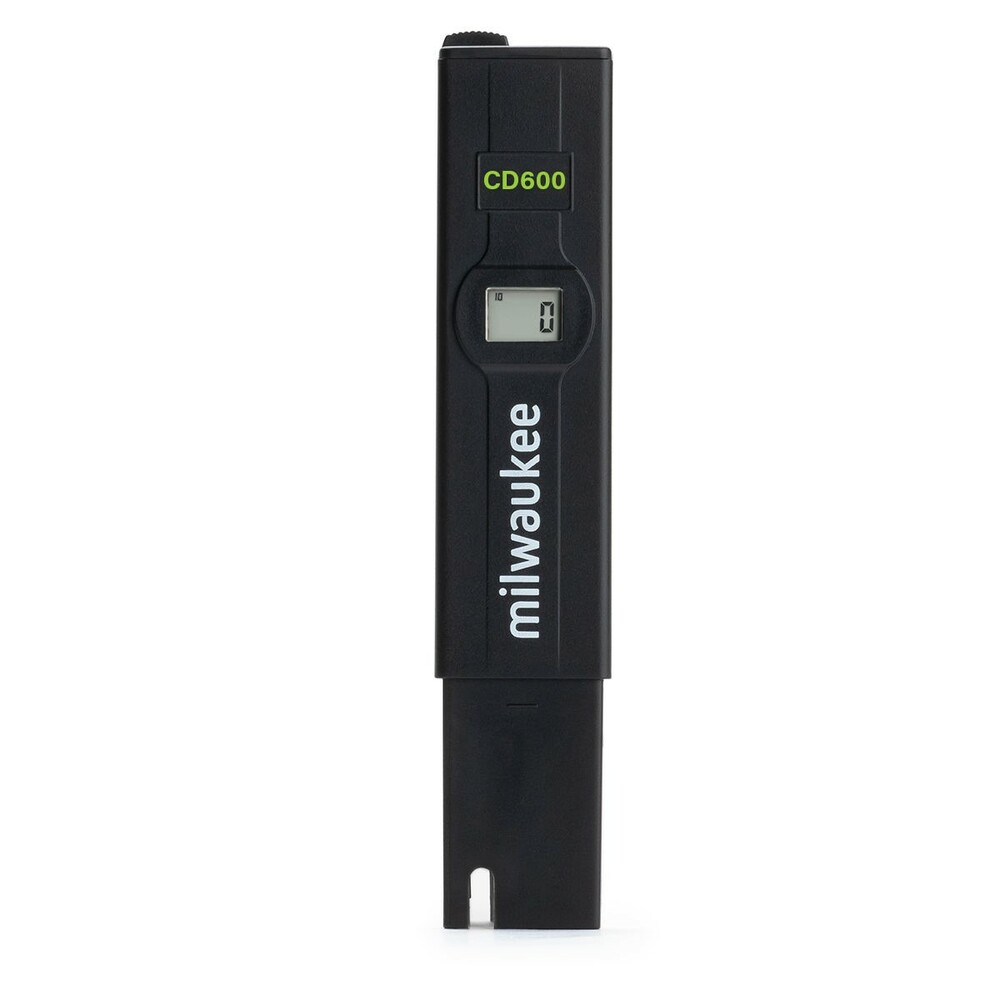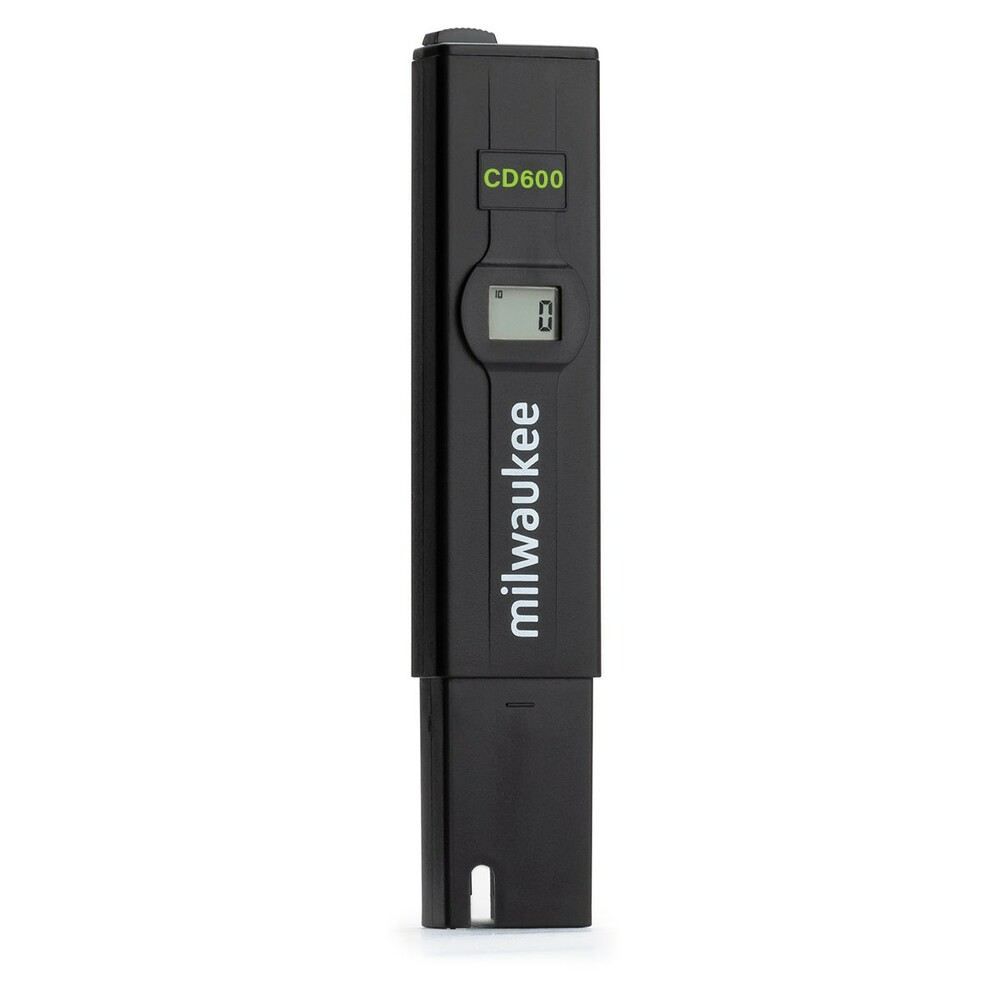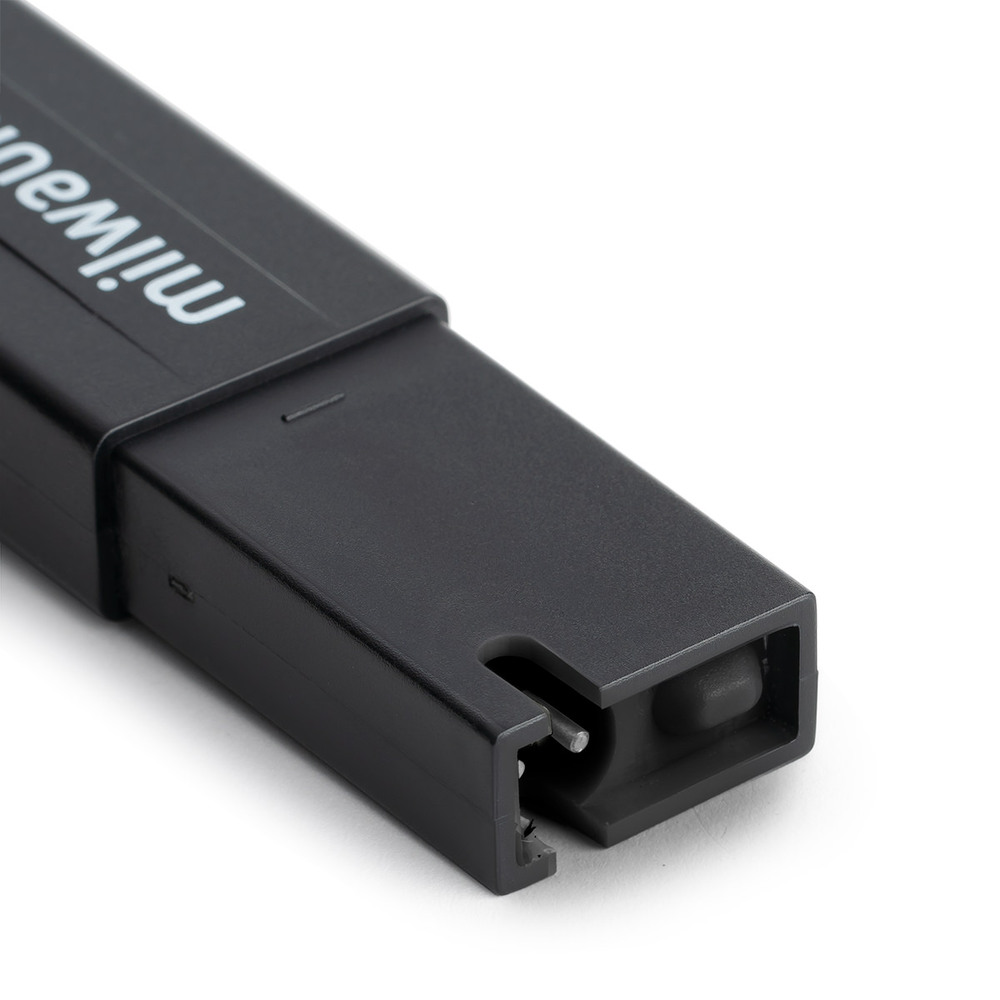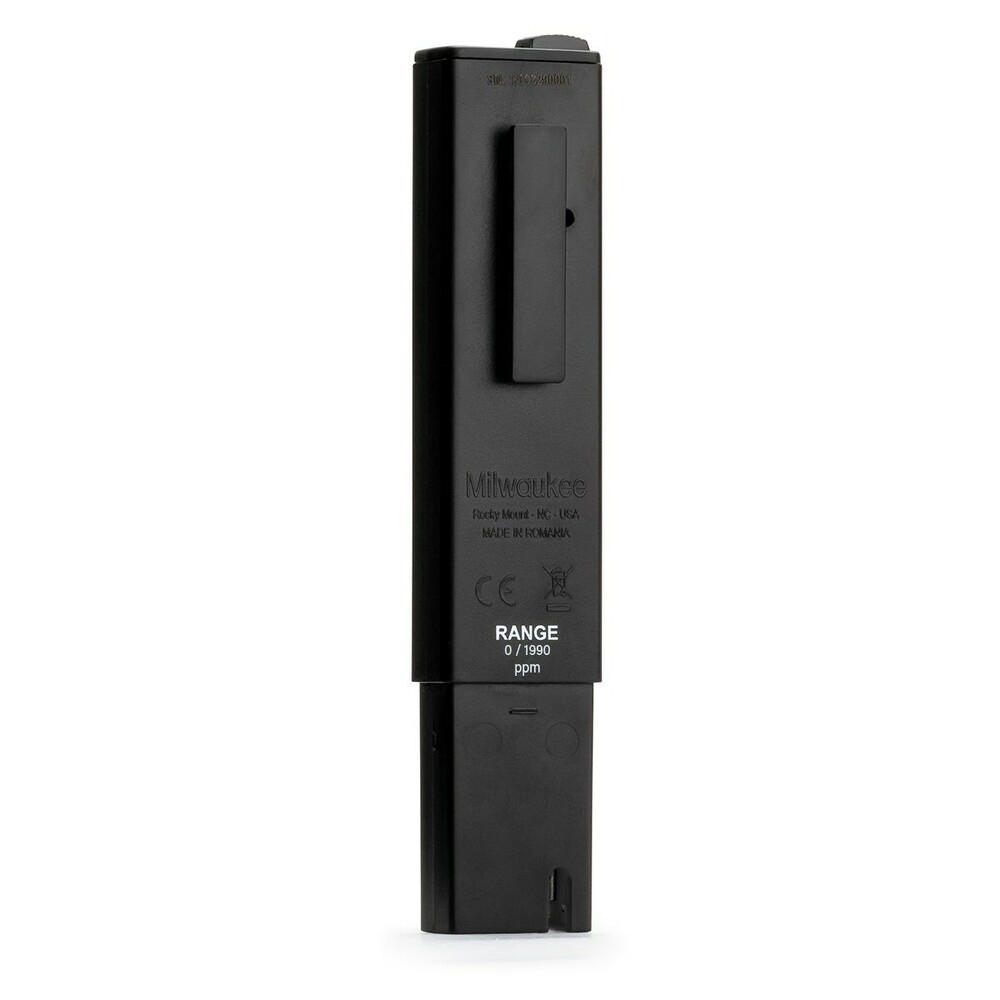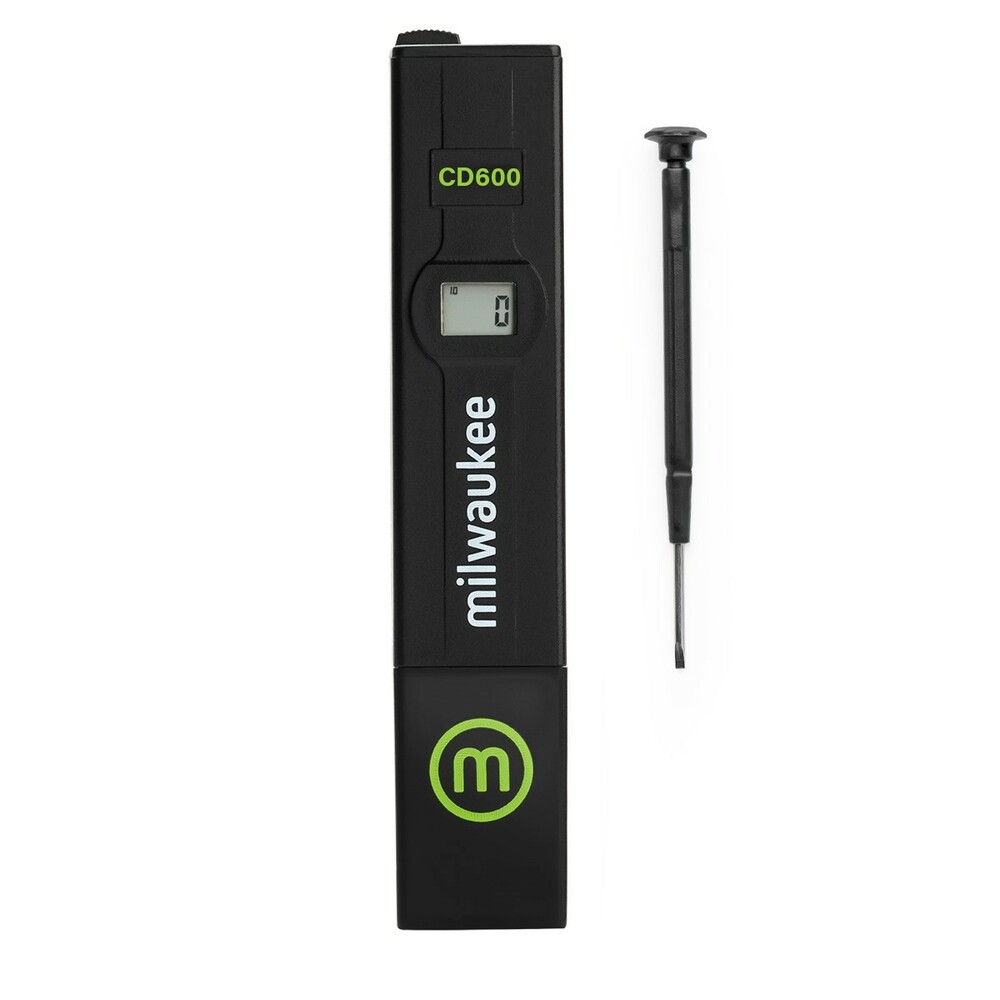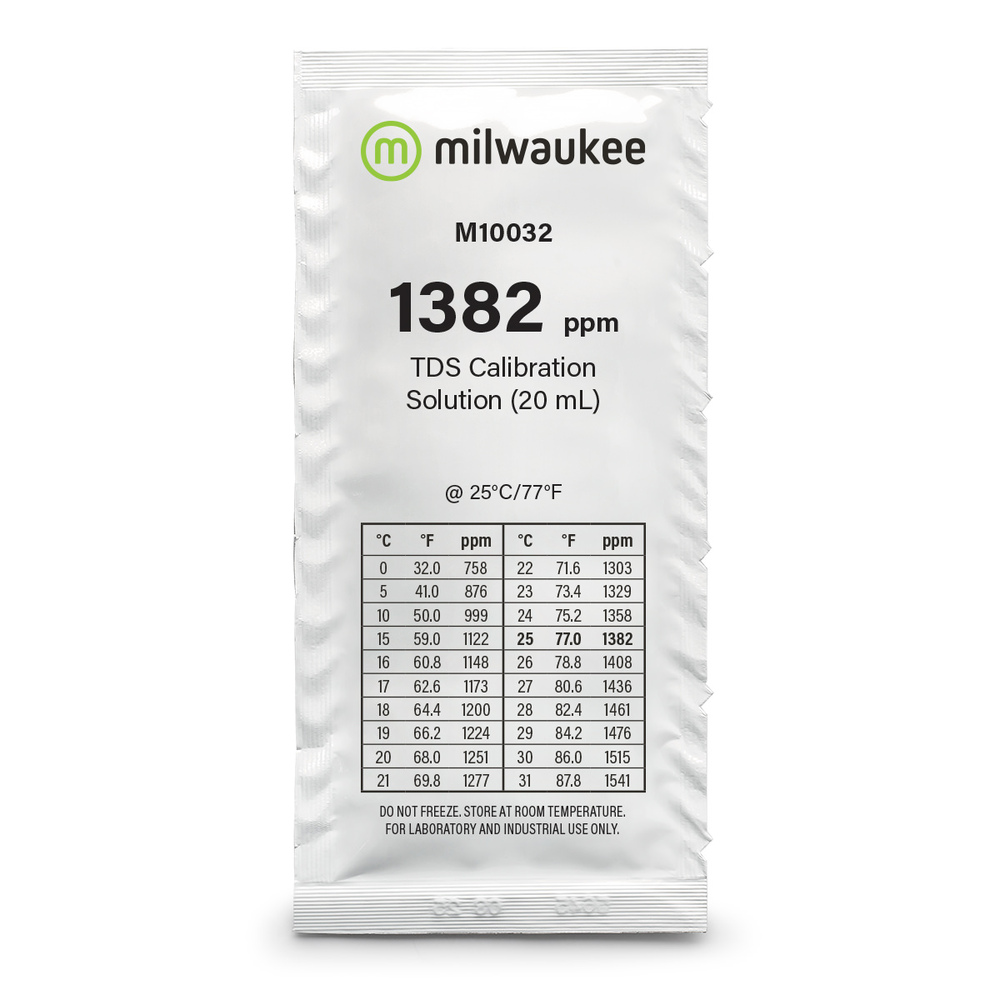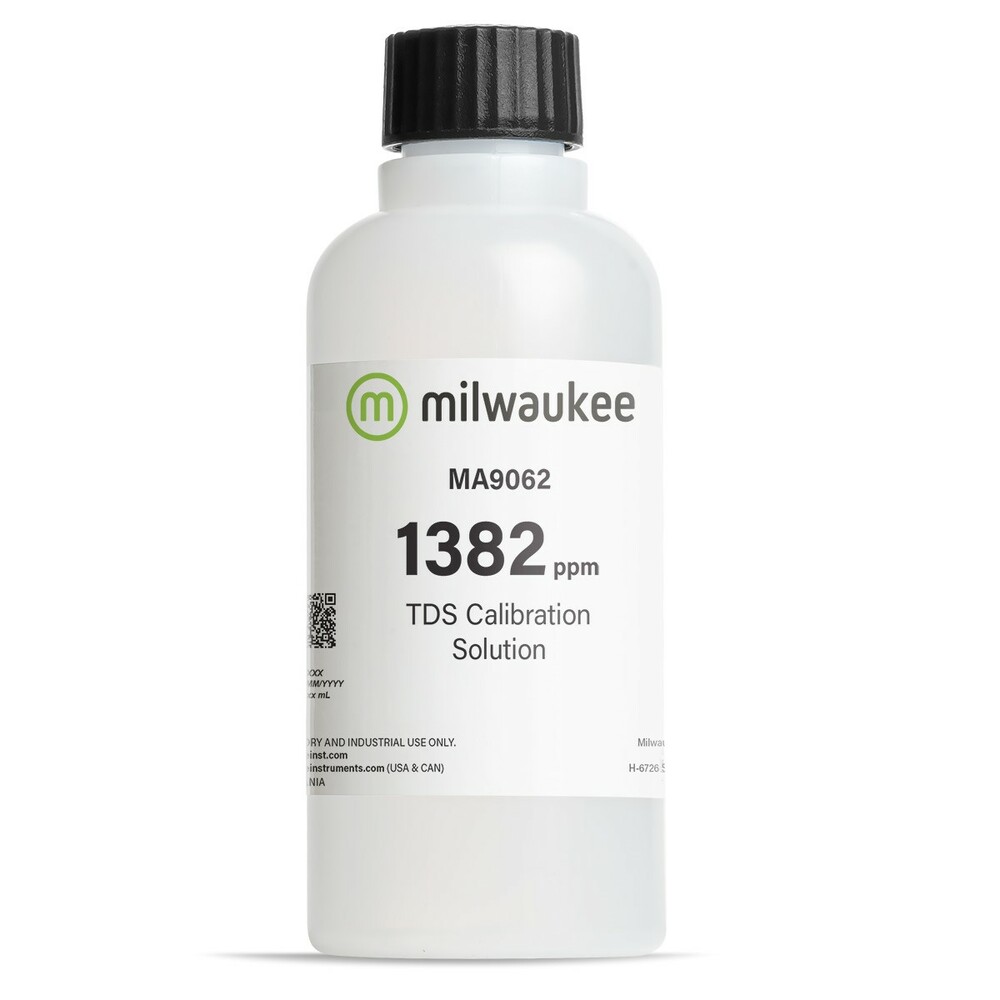Your shopping cart is currently empty.
Milwaukee CD600 Digital TDS Pen – Reliable Accuracy in the Palm of Your Hand
Whether you’re growing hydroponic vegetables, maintaining a crystal-clear aquarium, or fine-tuning a water filtration system, knowing your water’s Total Dissolved Solids (TDS) level is essential. TDS readings help determine whether your water is pure, nutrient-rich, or potentially problematic – and with the Milwaukee CD600 Digital TDS Pen, you get a professional-grade tool that’s accurate, fast, and built for real-world use.
Designed for growers, aquarists, water treatment specialists, and curious DIYers alike, the CD600 simplifies what used to be a lab-only task. With a single press, it gives you immediate insight into the quality of your water – no guesswork, no hassle. From checking nutrient concentrations to evaluating filter performance, this pen-style meter is your go-to companion for portable, on-the-spot TDS monitoring.
Engineered for simplicity and durability, the CD600 is compact enough to fit in your pocket but tough enough to deliver reliable readings day after day. Whether you’re in a greenhouse, kitchen, lab, or out in the field, this tool helps ensure your water meets the right standards every time.
Why Choose the Milwaukee CD600?
- Fast,
Accurate Readings
Get reliable TDS measurements in seconds, with ±2% full-scale accuracy, so you can make quick, informed decisions about your water quality. - User-Friendly
Design
With a simple one-button operation and easy-to-read digital display, the CD600 is intuitive for beginners and efficient for pros. - Ready
to Use
Comes factory-calibrated with a 1413 µS/cm calibration solution and includes a protective cap and batteries – everything you need to get started right away. - Portable
& Durable
Designed for one-handed use and built to last with a rugged ABS housing, the CD600 goes wherever you go. - Versatile
Applications
Ideal for hydroponics, aquariums, reverse osmosis systems, water treatment, environmental testing, beverage production, and more.
Applications at a Glance
- Hydroponics & Indoor Growing – Measure nutrient concentration to prevent under- or overfeeding.
- Aquariums & Aquaculture – Keep dissolved solids in check for healthier aquatic environments.
- Water Purification & RO Systems – Verify filter performance and ensure water quality.
- Drinking Water Testing – Quickly assess the safety and taste of your water supply.
- Industrial & Laboratory Use – Ensure consistent water quality in process environments and research settings.
Proper Care & Maintenance
To ensure long-lasting performance and accurate readings, follow these care tips:
Storage
Always store the CD600 with the protective cap on and away from extreme heat or humidity. While TDS meters don’t have glass bulbs like pH probes, keeping the sensor clean and dry when not in use helps extend its life.
Cleaning
Regularly rinse the probe with distilled or deionized water after each use to remove any residue that could affect measurement accuracy. If deposits or staining occur, gently clean the tip using a soft cloth or brush with isopropyl alcohol.
Calibration
Although the CD600 comes factory-calibrated, it’s good practice to recalibrate monthly or after heavy use. Use a standard TDS calibration solution (e.g., 1382 ppm NaCl) and follow the instructions in the user manual. Proper calibration ensures long-term accuracy.
Battery Maintenance
Replace batteries when the display dims or the meter becomes unresponsive. The CD600 uses 4 x 1.5V batteries, which are easy to change without tools.
CONVERTING TDS TO EC
The Milwaukee TDS Pen, like all TDS meters, provides a measure of Total Dissolved Solids (ppm) reading, of contaminates per unit of volume in a solution.
TDS/PPM is often converted to uS/cm. Different scales include the 500 scale, 650 scale and the 700 scale.
Your TDS/PPM readings can be approximately converted to uS/cm as shown in the examples below.
1 ppm = 2 uS/cm on the 0.5 factor scale
1 ppm = 1.43 µS/cm on the 442 scale or .70 factor scale
Thank you for considering Milwaukee to help you take your results to the next level.
Take control of your water quality today with the Milwaukee CD600 – compact, dependable, and ready for whatever challenge your water throws your way.
Specifications
Range: 0 to 1990 ppm
Application
Hydroponics & Indoor Gardening
Purpose: Monitor Nutrient Levels in Irrigation Solutions
In hydroponic and indoor gardening systems, water acts not only as a carrier for hydration but also as the primary medium for delivering essential nutrients to the plant roots. Because there is no soil to act as a buffer or nutrient reservoir, it becomes critical to measure and control what’s in the water at all times. This is where the Milwaukee CD600 TDS Pen becomes an indispensable tool.
Why TDS Matters: Precision Feeding for Healthy Growth
TDS (Total Dissolved Solids), measured in parts per million (ppm), provides a snapshot of the concentration of all dissolved nutrients and minerals in your nutrient solution. This includes nitrogen, potassium, calcium, magnesium, and other trace elements essential for plant development.
A solution that is too weak may lead to nutrient deficiencies, stunted growth, or poor yields. On the other hand, a solution that is too strong can cause nutrient burn, where excess salts accumulate at the root zone, damaging root cells and reducing nutrient uptake.
By regularly measuring TDS, growers can:
· Maintain optimal nutrient concentrations based on the plant’s growth stage (e.g., seedling, vegetative, flowering).
· Adjust fertilizer dosages with confidence.
· Avoid costly mistakes caused by guesswork or over-fertilization.
Benefits: Healthy Plants, Bigger Yields, Lower Costs
· Improved crop quality and yield by keeping plants within the optimal nutrient range.
· Reduced waste of fertilizers and nutrients by applying only what’s needed.
· Faster identification of issues, such as nutrient lockout or water quality problems.
· Consistency across batches, ideal for commercial growers who need repeatable results.
Whether you are growing leafy greens, herbs, tomatoes, or cannabis, precise TDS monitoring gives you complete control over your feeding program and unlocks the full potential of your crop.
How to Use the Milwaukee CD600 in Hydroponics
Here’s a step-by-step guide for using the CD600 to monitor nutrient concentrations in your hydroponic system:
1. Prepare Your Nutrient Solution
· Mix your hydroponic nutrients according to the manufacturer’s instructions.
· Allow the solution to stabilize for a few minutes.
2. Turn on the CD600
· Press the power button to activate the meter. The display will show “0” or the last recorded value.
3. Submerge the Probe
· Remove the protective cap.
· Insert the probe tip into the nutrient solution up to the marked immersion line.
· Gently stir the meter in the solution for 10–30 seconds to get an accurate reading.
4. Read the Display
· The TDS value in ppm (parts per million) will appear on the screen.
· Compare this value to your target range for the specific plant type and growth stage. For example:
o Seedlings: 400–600 ppm
o Vegetative stage: 800–1200 ppm
o Flowering/fruiting stage: 1000–1600 ppm
5. Adjust if Necessary
· If TDS is too low: add nutrients in small increments and recheck.
· If TDS is too high: dilute the solution with fresh water and re-measure.
6. Rinse and Store
· After use, rinse the probe tip with clean water.
· Shake off excess liquid, replace the cap, and store the meter in a dry place.
Water Purification & Filtration Systems
Purpose: Monitor and Validate Water Purity
In both residential and commercial settings, water purification systems like reverse osmosis (RO), carbon filtration, deionization, and distillation are essential for removing contaminants from drinking water, process water, or laboratory water. These systems are designed to filter out dissolved solids, which can include harmful substances such as lead, chlorine byproducts, nitrates, and excessive salts.
Over time, the effectiveness of these filters degrades due to clogging, fouling, or chemical saturation, which may go unnoticed until there's a significant decline in water quality. The Milwaukee CD600 TDS Pen provides a fast and reliable way to monitor this – helping you catch filter performance issues early and ensuring your water remains safe and clean.
Why TDS Matters: Your First Line of Defense
TDS (Total Dissolved Solids) levels are a key indicator of overall water purity. When water is purified properly, the TDS value should be dramatically lower after treatment than it is before. If TDS levels remain high even after filtration, it’s a strong signal that your system may be underperforming or that filters need replacement.
For example:
· Tap water may contain 200–500 ppm or more.
· Properly functioning RO systems often reduce that to 5–50 ppm, depending on source water and membrane quality.
· A sudden rise in TDS post-filtration could indicate membrane failure, filter exhaustion, or contamination.
Benefits: Confidence in Every Drop
· Ensure water quality for drinking, cooking, medical use, or sensitive industrial processes.
· Track system performance over time and know exactly when maintenance or filter replacement is needed.
· Avoid guesswork and reduce the risk of using substandard or contaminated water.
· Save costs by replacing filters only when truly necessary – not prematurely.
How to Use the Milwaukee CD600 for Filtration System Testing
Whether you're testing an RO system at home, a commercial filter in a café, or lab-grade distilled water, here’s how to make the most of your CD600.
1. Collect Pre- and Post-Filtration Samples
· Before sample: Collect a small amount of the unfiltered source water (e.g., tap water entering the system).
· After sample: Collect water after it has passed through your purification system.
2. Turn on the CD600
· Press the power button to activate the display.
· Ensure the meter is clean and dry before testing.
3. Test the Source (Pre-Filtration) Water
· Remove the protective cap.
· Immerse the probe tip into the pre-filtration sample.
· Gently stir the meter in the water for 10–30 seconds.
· Record the reading shown (e.g., 380 ppm).
4. Test the Filtered (Post-Filtration) Water
· Rinse the probe with distilled or RO water to avoid cross-contamination.
· Dip the probe into the post-filtration sample.
· Wait for a stable reading and note the value (e.g., 12 ppm).
5. Evaluate the Filtration Performance
· Compare the before and after TDS readings.
·
Calculate removal efficiency:
(SourceTDS–FilteredTDS)÷SourceTDS×100=(Source TDS – Filtered TDS) ÷ Source TDS
× 100 = % Removed(SourceTDS–FilteredTDS)÷SourceTDS×100=
Example: (380 – 12) ÷ 380 × 100 ≈ 96.8% removal
· Most high-quality RO systems remove 90–99% of TDS.
6. Rinse and Store
· After use, rinse the probe tip with clean water.
· Shake off excess moisture, replace the protective cap, and store the meter safely.
Aquariums (Freshwater and Marine)
Purpose: Maintain Stable, Healthy Water Conditions for Aquatic Life
In both freshwater and marine aquariums, maintaining consistent water quality is essential to the well-being of fish, invertebrates, plants, and corals. Total Dissolved Solids (TDS) is a key metric that reflects the overall mineral and salt concentration in the water, and it plays a vital role in osmoregulation – the process by which aquatic organisms maintain the right balance of fluids and electrolytes.
The Milwaukee CD600 Digital TDS Pen allows aquarists to quickly and accurately monitor these levels, ensuring that the water environment remains within the optimal range for their specific tank inhabitants.
Why TDS Matters: Invisible, Yet Critical
TDS doesn’t tell you what’s dissolved in the water – just how much – but that's still powerful information. High TDS values may point to:
· Buildup of waste products, uneaten food, and fish waste.
· Mineral accumulation over time (e.g., from top-offs with tap water).
· Malfunctioning filtration or inefficient water changes.
In freshwater tanks, TDS ranges typically fall between 100–300 ppm, depending on species:
· Soft-water species (e.g., tetras, discus): prefer 50–150 ppm.
· Hard-water species (e.g., African cichlids): thrive in 200–400 ppm.
In marine and reef tanks, TDS is especially useful for:
· Monitoring make-up water (e.g., RO/DI water) used for saltwater mixing. RO/DI water should have 0–5 ppm TDS to avoid introducing unwanted minerals.
· Verifying fresh top-off water used for evaporation compensation.
TDS levels that drift too far from the target range can stress aquatic animals, compromise their immune systems, lead to disease, and even cause death. Regular monitoring helps prevent sudden shifts and improves long-term stability.
Benefits: A Safer Home for Your Aquatic Companions
· Helps ensure optimal water chemistry tailored to the species in your tank.
· Prevents osmotic shock, one of the leading causes of stress in fish.
· Enhances success in breeding, coral growth, and long-term fish health.
· Detects problems before symptoms appear in your aquatic life.
· Complements other parameters (e.g., pH, ammonia, nitrate) for a complete water quality profile.
How to Use the Milwaukee CD600 in Aquariums
Use the CD600 to monitor both tank water and source water (e.g., tap, RO/DI, or premixed saltwater). Here’s a step-by-step guide:
1. Collect Your Water Sample
· For tank water: Scoop a clean sample in a glass or plastic cup.
· For source water: Collect from the RO/DI system or tap before adding it to the tank.
2. Power On the CD600
· Press the button to turn on the device.
· Wait for the display to initialize.
3. Immerse the Probe
· Remove the protective cap.
· Dip the probe tip into the water sample to the indicated immersion line.
· Gently swirl the meter to ensure a consistent reading.
4. Read and Record the Value
· Within seconds, the display will show the TDS reading in ppm.
· Compare the reading to your target TDS range:
o RO/DI Water: 0–5 ppm
o Freshwater Aquarium: 100–300 ppm (varies by species)
o Saltwater Mixing Water: Verify TDS of base water (RO/DI) before mixing
5. Take Action If Needed
· If TDS is too high: Perform a partial water change or verify filter performance.
· If TDS is too low (rare in aquariums): Recheck with other instruments (e.g., GH/KH test kits) to ensure no measurement error.
6. Rinse and Store
· Rinse the probe with distilled or RO water after use.
· Shake off any excess water, replace the cap, and store the meter in a dry location.
Drinking Water Quality Monitoring
Purpose: Ensure Your Water is Safe, Clean, and Tastes Great
Water is one of the most essential substances we consume daily, and its quality directly impacts our health, comfort, and overall well-being. While most municipal water supplies are regulated and treated, the actual quality of the water at your tap or faucet can vary based on several factors – aging pipes, local infrastructure issues, or contamination from external sources.
Whether you rely on municipal water, well water, or a bottled water source, it's important to monitor what's in it. The Milwaukee CD600 Digital TDS Pen provides a quick, reliable, and cost-effective way to evaluate your drinking water's purity and consistency. It helps you detect changes in water quality and ensures your water remains within safe and acceptable TDS limits.
Why TDS Matters: Clarity Behind the Numbers
TDS (Total Dissolved Solids), measured in parts per million (ppm), reflects the concentration of all inorganic and organic substances dissolved in water – including minerals, salts, metals, and potential contaminants.
Not all dissolved solids are harmful. In fact, moderate levels of minerals like calcium and magnesium can enhance taste and support health. However, excessively high TDS levels can:
· Affect taste (e.g., metallic, bitter, or salty flavor)
· Cause scaling in kettles, appliances, or pipes
· Indicate contamination from heavy metals, pesticides, or industrial runoff
· Hinder people with specific health conditions (e.g., kidney disease, sodium sensitivity)
Guidelines vary slightly by region, but general benchmarks include:
· 0–50 ppm – Very low TDS (distilled or RO water)
· 50–150 ppm – Excellent for drinking; crisp taste
· 150–300 ppm – Acceptable and typical for many municipalities
· 300–500 ppm – Still safe, but may impact taste or appliance lifespan
· Above 500 ppm – May be unsuitable for long-term consumption per EPA recommendations (USA)
Benefits: Confidence in Every Sip
· Monitor source and filtered water at home, work, or while traveling
· Track changes over time to detect problems like pipe corrosion or filter failure
· Validate bottled water quality or compare different brands
· Ensure RO, distillation, or pitcher filters are working properly
· Stay compliant with local or personal water safety standards
How to Use the Milwaukee CD600 for Drinking Water Monitoring
Perfect for homeowners, renters, wellness enthusiasts, or professionals, here's how to use the CD600 to evaluate your drinking water:
1. Collect Your Water Sample
· Use a clean, odorless glass or plastic container.
· Let cold tap water run for 10–20 seconds before filling the cup to flush out stagnant water.
2. Power On the CD600
· Press the power button to activate the device.
· Ensure the LCD display is functioning and clean.
3. Immerse the Probe
· Remove the protective cap.
· Insert the probe tip into the water sample up to the immersion line.
· Gently swirl or stir to help stabilize the reading.
4. Read the TDS Value
· The digital screen will display the TDS level in ppm.
· Compare the result to accepted TDS ranges for drinking water.
o 50–300 ppm is ideal for most users.
o Above 500 ppm: investigate further or use filtration.
5. Assess and Respond
· If the reading is unexpectedly high, test:
o A second sample from a different tap or time of day.
o Water after filtration (e.g., from an RO or carbon filter).
· If both readings are high, consider installing or replacing your water filter system or testing for specific contaminants using a laboratory or certified test kit.
6. Clean and Store
· After each use, rinse the probe with RO or distilled water.
· Shake gently to remove excess moisture.
· Replace the protective cap and store in a cool, dry place.
Pools and Spas
Purpose: Monitor Water Quality to Prevent Scaling, Corrosion, and Chemical Imbalance
Water chemistry in pools and spas is more than just pH and chlorine – Total Dissolved Solids (TDS) is a crucial but often overlooked parameter that affects overall water health. TDS represents the sum of all substances dissolved in the water, including calcium, sodium, chlorides, sulfates, metals, and organic matter.
Over time, as water evaporates and chemicals are added (chlorine, algaecide, pH balancers, etc.), TDS levels gradually increase. Unlike pH or chlorine, TDS cannot be adjusted with a chemical, and when it gets too high, it creates problems that are both costly and harmful.
The Milwaukee CD600 TDS Pen gives pool and spa owners a fast, portable solution for checking dissolved solid buildup, helping them maintain cleaner, more comfortable, and safer water.
Why TDS Matters: Protecting Water Balance and Equipment
While moderate TDS levels are expected in pools and spas, excessively high TDS can:
· Interfere with chlorine efficiency, reducing sanitizing power and requiring more chemicals
· Promote cloudy water and algae growth
· Cause scaling on pool walls, plumbing, and heating elements
· Corrode metal fixtures, ladders, and equipment
· Irritate skin and eyes due to chemical imbalance
Recommended TDS levels vary:
· Swimming pools: 1000–2000 ppm (depending on source water and chemical usage)
· Spas and hot tubs: 1500–3000 ppm (due to higher temperatures and bather loads)
When TDS exceeds 1500 ppm above the starting source water, it's generally time to partially drain and refill the pool or spa.
Benefits: Cleaner Water, Lower Costs, Longer Equipment Life
· Maintain balanced water chemistry without overusing chemicals
· Improve chlorine efficiency, reducing chemical usage and cost
· Prolong the life of heaters, filters, and pumps
· Prevent expensive repairs caused by corrosion or scaling
· Ensure crystal-clear water for comfort and aesthetics
How to Use the Milwaukee CD600 in Pools and Spas
Use the CD600 regularly – ideally weekly – as part of your routine pool or spa maintenance. Here’s how to do it:
1. Collect a Water Sample
· Use a clean plastic cup or water testing bottle.
· Take the sample from about elbow-depth in the pool or spa to avoid surface impurities.
2. Turn on the CD600
· Press the power button to activate the meter.
· Confirm the display is clear and the battery is functioning.
3. Insert the Probe
· Remove the cap and immerse the probe tip into the sample.
· Stir gently for 10–30 seconds to stabilize the reading.
4. Read the TDS Value
· Once the reading is stable, note the value in ppm.
· Compare it to your baseline (e.g., the starting TDS after the last full water change).
5. Take Action Based on the Reading
· If TDS is within range: No action needed.
· If TDS is 1000–1500 ppm above source water:
o Perform a partial drain and refill with fresh water.
· If cloudy water or sanitizer inefficiency occurs despite low TDS:
o Check pH, alkalinity, and chlorine to rule out other causes.
6. Rinse and Store
· After use, rinse the probe with distilled or pool water.
· Shake dry and replace the protective cap.
· Store in a dry, shaded area away from direct sunlight.
Food and Beverage Industry
Applications: Breweries, Wineries, Coffee Roasters & Food Processing
In the food and beverage industry, water is more than just an ingredient – it's the foundation. Whether you're brewing craft beer, fermenting wine, distilling spirits, or manufacturing beverages like tea, juice, or soda, the quality and consistency of the water you use has a direct impact on product taste, stability, and regulatory compliance.
Likewise, in food processing – especially where water is used for cleaning, dissolving, soaking, or as a medium for ingredient transfer – TDS levels play a critical role in maintaining product uniformity and food safety.
The Milwaukee CD600 Digital TDS Pen offers a fast, reliable, and portable solution to monitor water mineral content, helping businesses ensure consistent taste profiles, reduced batch variability, and clean processing lines.
Why TDS Matters: A Hidden Flavor Factor
Total Dissolved Solids (TDS) include calcium, magnesium, sodium, chloride, sulfates, and organic matter – all of which can influence the flavor, texture, appearance, and pH behavior of finished products. High or fluctuating TDS levels can:
· Alter taste (e.g., bitterness in coffee, harshness in spirits)
· Impact yeast performance in fermentation
· Cause scaling or fouling in kettles, lines, and heat exchangers
· Lead to inconsistent batches, especially in beverages where water is the main ingredient
Industry professionals know that repeatable product quality starts with water consistency. By incorporating TDS monitoring into standard operating procedures, businesses gain more control, reduce waste, and protect brand reputation.
Examples of Use:
· Breweries: Control water hardness for mash profiles and fermentation.
· Wineries: Ensure low TDS in rinsing and bottling water to preserve wine characteristics.
· Coffee shops and roasters: Calibrate water for ideal extraction and flavor clarity.
· Distilleries: Achieve consistent dilution ratios with pure water during proofing and bottling.
· Food processing plants: Monitor process water to comply with hygiene and taste standards.
How to Use the Milwaukee CD600 in Food & Beverage Applications
This guide assumes you're testing process water, ingredient water, or cleaning rinse water – all critical points in beverage and food production lines.
1. Collect a Water Sample
· Use a clean, food-safe container (preferably glass or stainless steel).
· If testing filtered or treated water, sample after the final filtration point.
· For ingredient water, test before it enters the batch process.
2. Power on the CD600
· Press the power button until the screen activates.
· Make sure the display reads “0” or shows a stable baseline.
3. Dip the Probe
· Remove the protective cap.
· Immerse the probe in the sample up to the immersion mark.
· Gently agitate or swirl the meter to stabilize the reading.
4. Read the TDS Measurement
· Wait 10–30 seconds for a stable result.
· Compare the reading to your quality control standards or recipe profile.
Suggested TDS Ranges:
· Coffee brewing water: 75–250 ppm (ideal flavor extraction)
· Bottling/rinsing water: <50 ppm to avoid taste impact
· Fermentation prep water: Varies by yeast strain and product, often <150 ppm
· Distillation dilution: <10 ppm for high-purity final products
5. Take Action
· If TDS is too high: Recalibrate filtration systems (e.g., carbon or RO), or change the water source.
· If readings are inconsistent between batches: Audit water treatment and mixing processes.
6. Rinse and Store
· Rinse the probe with RO or distilled water.
· Shake off excess moisture.
· Cap the device and store it safely away from heat or contamination.
Environmental Water Testing
Purpose: Monitor Natural Water Sources for Health and Contamination
Understanding the chemical makeup of natural water bodies – such as lakes, rivers, streams, ponds, and groundwater – is essential for preserving ecosystems, tracking pollution, and guiding conservation policy. One of the quickest ways to assess changes in water quality is by measuring Total Dissolved Solids (TDS), which reflects the combined content of all inorganic and organic substances present in a sample.
The Milwaukee CD600 Digital TDS Pen is a portable, battery-powered tool ideal for on-site water testing in field conditions. It provides instant TDS readings that can help identify potential pollution, evaluate runoff impacts, and determine whether water is safe for wildlife, agricultural use, or human contact.
Why TDS Matters: A Snapshot of Water Health
In natural environments, elevated or abnormal TDS levels may indicate:
· Agricultural runoff (fertilizers, pesticides, and livestock waste)
· Urban pollution (road salt, motor oil, heavy metals)
· Industrial discharge or mining waste
· Sewage leaks or failing septic systems
· Erosion increasing sediment and mineral content
Consistently high TDS readings in rivers, lakes, or groundwater may signal long-term environmental stress, while sudden spikes can point to recent contamination events. Conversely, unusually low TDS levels may affect aquatic biodiversity by depriving ecosystems of essential minerals.
TDS values vary by region and ecosystem, but typical ranges are:
· Pristine mountain streams: 0–50 ppm
· Healthy lakes and rivers: 100–400 ppm
· Agriculturally impacted water: 500–1500+ ppm
· Heavily polluted sources: >2000 ppm
Benefits: Field-Ready Data for Informed Decision-Making
· Rapid detection of environmental threats and pollution events
· Enables trend monitoring and comparison over time or seasons
· Supports compliance efforts with government environmental standards
· Assists in ecological restoration and waterway protection programs
· Ideal for citizen science, school field trips, and academic research
How to Use the Milwaukee CD600 for Environmental Testing
The CD600 is designed for field usability – compact, durable, and easy to operate without lab infrastructure. Here’s how to conduct TDS testing in nature or field conditions:
1. Select and Prepare Sampling Site
· Choose a representative site for your study – ideally away from standing water and with minimal debris.
· If collecting groundwater, use a clean container or access an existing well or pump tap.
2. Collect a Water Sample
· Use a clean, non-reactive container (glass or plastic).
· For rivers or lakes: collect from below the surface (6–12 inches) to avoid surface debris.
· Avoid touching the inside of the container to prevent contamination.
3. Power On the CD600
· Turn the device on using the power button.
· Ensure the display is functioning properly before proceeding.
4. Immerse the Probe
· Remove the protective cap.
· Submerge the probe tip into the water sample or directly into the body of water.
· If testing on-site (in-situ), hold the meter steadily and avoid stirring up sediment.
5. Wait for Reading Stabilization
· Gently agitate the device or sample for 10–30 seconds.
· When the reading stabilizes, record the TDS value in ppm (parts per million).
6. Log and Compare
· Record sample location, date/time, temperature (if available), and TDS.
· Compare results with local or national environmental thresholds (e.g., EPA, WHO, or EU standards).
· For best results, take multiple samples across different areas or depths.
7. Rinse and Store
· Rinse the probe with deionized water if available, or clean sample water if not.
· Dry gently, replace the cap, and store in a protective case between locations.
Education and Research
Purpose: Bring Water Science to Life Through Hands-On Exploration
In educational environments – from middle school science classrooms to university chemistry labs – hands-on experiences are essential for engaging students and reinforcing scientific concepts. The Milwaukee CD600 Digital TDS Pen is an ideal tool for teaching and research settings, enabling users to easily test water quality and explore the invisible world of dissolved solids in real time.
TDS (Total Dissolved Solids) measurements offer a gateway to discussions and explorations of water chemistry, ion behavior, environmental systems, pollution monitoring, filtration technologies, and even human health. With its intuitive design and immediate digital readout, the CD600 empowers students to perform accurate, meaningful experiments without needing complex lab setups.
At the university level, it supports more advanced applications, including field research, environmental impact studies, water treatment assessments, and quality assurance trials.
Why TDS Matters: From Theory to Real-World Application
TDS reflects the total quantity of dissolved substances in water, such as:
· Inorganic salts: calcium, sodium, chlorides, sulfates
· Organic compounds: humic acids, algae byproducts, dissolved organics
· Pollutants: fertilizers, detergents, heavy metals
Understanding TDS helps students:
· Grasp how ion exchange, osmosis, and conductivity relate to real-world systems
· See how water quality varies between sources like tap water, bottled water, lakes, and rain
· Explore the effects of human activity on local ecosystems
· Analyze changes in water before and after filtration or chemical treatment
Benefits: Learning by Doing
· Enhances STEM curriculum with accessible, data-driven experiments
· Encourages scientific inquiry and critical thinking
· Allows for safe, portable testing in classrooms, labs, or the field
· Supports independent student research, science fair projects, and capstone studies
· Helps instructors demonstrate real-time environmental or chemical principles
How to Use the Milwaukee CD600 in Educational & Research Settings
This guide works for educators, lab technicians, and students conducting water quality experiments or comparative analysis.
1. Select Your Water Samples
· Choose water from diverse sources for comparison:
o Tap water, distilled water, bottled water
o Rainwater, lake/river water, wastewater
o Filtered vs. unfiltered samples
· Label each sample clearly for proper data logging.
2. Turn on the CD600
· Press the power button to activate the device.
· Ensure the display is clear and the batteries are charged.
3. Insert the Probe into Each Sample
· Remove the protective cap from the meter.
· Submerge the probe tip into the sample (up to the immersion line).
· Gently swirl or stir the meter to stabilize the reading.
4. Record the TDS Reading
· Wait for the screen to stabilize (usually within 10–30 seconds).
· Record the value in ppm (parts per million) along with the sample name.
· Repeat for each water sample.
5. Analyze and Compare Results
· Have students compare TDS levels:
o Which source has the highest TDS?
o How does filtration change TDS?
o How do results correlate with water clarity, taste, or odor?
· For advanced classes: graph the results, calculate averages, or correlate with other measurements like pH or turbidity.
6. Clean and Store the Meter
· Rinse the probe with distilled or deionized water after each use.
· Shake gently, replace the cap, and store the device in a dry location.



